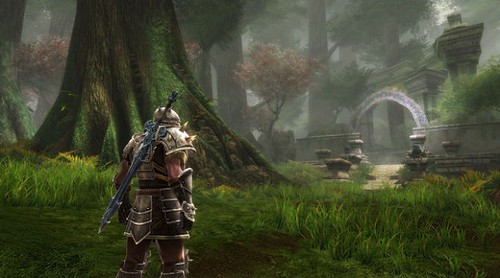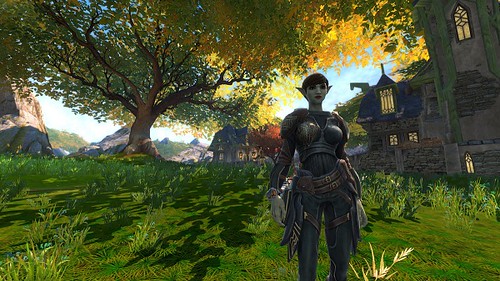|
Disclosure: We may earn a commission from links on this page
|
Developer: 38 Studios, Big Huge Games | Publisher: Electronic Arts |
| Release Date: February 7, 2012 | Available On: PC, PS3 and Xbox 360 |
2011 will forever go down in history as one of the greatest years in gaming. Whether you are a First Person Shooter fan, Action Adventure, or maybe you just like to dance, 2011 held something for just about everyone. RPG fans, however, were treated especially well, getting hammered month after month by top quality RPGs like The Witcher 2, Deus Ex: Human Revolution, Star Wars: Knights of the Old Republic, Elder Scrolls V: Skyrim, Dark Souls – the list goes on and on. After such generosity to the RPG community, how can 2012 possibly stack up? And how can you possibly find time for any more quests in your day? EA and Big Huge Games have decided to answer both questions early this year, with their big huge open-world RPG, Kingdoms of Amalur: Reckoning.
Kingdoms of Amalur: Reckoning is backed by a powerhouse of developers and publishers. In addition to EA and BHG being veterans of the craft: acclaimed fantasy novelist R.A. Salvatore, comic book artist Todd Mcfarlane (Spawn), and Ken Rolston (The Elder Scrolls) are all on board working on story, graphics/art detail and design/production, respectively. It is essentially the 1996 Chicago Bulls of development teams.

With no lack of talent, and no foreseeable lack of funds, magic is bound to happen. While being unique and individual in its own right, Kingdoms of Amalur is more of a culmination of the good aspects of all RPG games bundled into one. You will hear comparisons and accusations of Kingdoms of Amalur resembling all of these other great RPGs, but pay them no heed. While there is some merit to that, Kingdoms of Amalur: Reckoning has gone out of its way to show that just because something’s been done before doesn’t mean it can’t be done better.
Kingdoms of Amalur: Recoking takes place in the middle of a great war. The “Crystal War” is spearheaded by the Tuatha – magical beings who are a subsection of the bigger Immortal Winter Fae – in an attempt to rid Amalur of all mortal races. You fill the shoes of a dead mortal. At least you were supposed to be dead, until the invention of great gnomish investor Fomorous Huges’s, the “Well of Souls”, magically revives you. Without any memories of your previous life, Fomorous dubs you the “Fateless One” and helps you escape the facility from the invading Tuatha.
That’s not to say that the story itself is bad, it just seems a little underemphasized throughout the game. Just because the main story feels softened does not mean that there is any lack of content to immerse you into the world. You’ll learn about the lore scattered throughout the world in the form of Lorestones, which act as sort of an audio log into the past of the current area you are exploring. Villagers and townsfolk will shower you with information regarding the land, the war, the different races and so forth. Even certain item descriptions will tell you tales of fallen warriors and battles once fought. It won’t take long for you to truly feel like you know the world and to form alliances (even if just in your mind) to certain races, clans or groups.
While Kingdoms of Amalur’s story and art direction separate it from the games mentioned in the beginning of this article, its gameplay is where it does most of its borrowing. The accumulation of many different gameplay elements is executed so that Kingdoms of Amalur is a wonder to play rather than just a copycat. The usual tropes of the modern RPG are present and you’re strongly encouraged to take advantage of all of them:
- Alchemy – Throughout the world of Amalur you’ll come across various ingredients, usually called “regents” that you can use to create potions with powerful effects. You can mix and match ingredients at you discretion by “experimenting”, or use various recopies that can be found or bought for specific results.
- Blacksmithing – Weapons and armor can be bought, found, or created through the blacksmith forge. Using various parts including blades, grips, hilts, even bearings, you can create custom weapons with custom effects, depending on what parts you use. As you level up your Blacksmithing skill you’ll be able to add more parts to your creation.
- Sagecrafting – After obtaining your shiny new armor or weapons you’ll want to fine-tune and upgrade it at the Sagecrafting Altar. The Altar allows you to “socket” various gems into certain weapons or armor. Gems can be found or created by combining “shards” that you’ll find scattered about your journeys. Mixing and matching gems grants certain bonuses, perks and multipliers to your equipment.
Exploring the world of Amalur primarily takes place by foot with the option to fast travel to towns or specific spots on the map that you’ve visited before. You’re also allowed to sprint, but there is no stamina meter, making getting from place to place quick and easy. Along your travels you will find treasure chests to loot, lock pick or dispel, plants with valuable regents to pluck, and hidden goodies around every corner. The only drawback to having so much loot is the fact that the drop-down menu system can feel cluttered at times and you will often have to scroll down through long lists to find the item you are looking for.
Kingdoms of Amalur’s combat is where the game truly shines. Whether you are traversing the Forsaken Plain or rummaging through abandoned ruins, there are always enemies to be slain. Kingdoms of Amalur gives up hardcore number crunching, simple attacks and turn-based encounters for a more action-based fighting system. It looks like a Devil May Cry type of game on the outside, but doesn’t quite feel like it. Your character will fall into one of three main classes: Sorcerer, Warrior, or Thief/Rogue/Assassin. You are not bound to any particular class, and you can reset your skills at any time in the game by visiting a Fateweaver (for a price).
Your character will wield a primary weapon and a secondary weapon. What weapons you chose, whether the classic long sword or quick daggers, is entirely up to you. Using your two weapons and choice of magic, you hack and slash your way through any opposition. The fighting is fun, varied, and very cinematic. The controls could be a little tighter, however, and there will certainly be times where you “definitely dodged”. The system is fairly unique in the realm of RPGs but I can’t help but wish they had employed a more sophisticated combo system.

Good story and good gameplay so far, yet it is not the best part. If I could, I would write an entire review dedicated to Kingdoms of Amalur’s presentation. The art team has done absolutely everything they can to make this world look beautiful and feel alive. Character models aren’t mind-blowing by any means, but they fit perfectly within the world. Colors are bright and emphasized throughout Amalur.
The sunlight cascades over the lands creating an awe-inspiring glow and contrasting shadows that will constantly make you question how anyone could possibly create such a world. Lord of the Rings-esque sci-fi fantasy music gently fades in and out as you explore, seeming to set the mood perfectly for the area you are in. Hats off to the art team on this one.
Is Kingdoms of Amalur the best RPG you have ever played? Maybe not, but it’s going to be pretty high up on your list. If you are easily addicted to open world games with an overwhelming amount of content and things to do, then don’t buy this game. If you do, you may actually give up your real life.
br>
| Graphics: | 9 |
| Sound: | 9.5 |
| Gameplay: | 8.5 |
| Creativity: | 7.5 |
| Replay Value/Game Length: | 9.5 |
| Final: | 8.8 out of 10 |
| Written by Matthew Evangelista | Write a User Review |